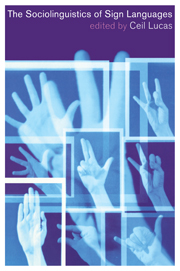Book contents
- Frontmatter
- Contents
- List of figures
- List of tables
- List of contributors
- Foreword
- Preface and acknowledgments
- List of abbreviations
- 1 Introduction
- 2 Multilingualism: The global approach to sign languages
- 3 Bilingualism and language contact
- 4 Sociolinguistic variation
- 5 Discourse analysis
- 6 Language planning and policy
- 7 Language attitudes
- Bibliography
- Index
Preface and acknowledgments
Published online by Cambridge University Press: 24 November 2009
- Frontmatter
- Contents
- List of figures
- List of tables
- List of contributors
- Foreword
- Preface and acknowledgments
- List of abbreviations
- 1 Introduction
- 2 Multilingualism: The global approach to sign languages
- 3 Bilingualism and language contact
- 4 Sociolinguistic variation
- 5 Discourse analysis
- 6 Language planning and policy
- 7 Language attitudes
- Bibliography
- Index
Summary
This book grew directly out of my experience in teaching a graduate-level course entitled Sociolinguistics in Deaf Communities at Gallaudet University in Washington, DC, and out of my frustration at not having one unified self-contained text to use for the course. I have been teaching this course since the early 1980s. When I first taught the course, the readings that pertained specifically to Deaf communities came mostly from work on diglossia by Stokoe, work on variation and language contact by Woodward and others, and work on conversational structure by Baker. All this material was published in the late 1960s and early 1970s. However, since the early 1980s, with the ever-growing recognition and acceptance of sign languages as real languages and with the continuing empowerment of deaf people, the field of sign language sociolinguistics has virtually exploded. There is work to report on from all of the major areas of sociolinguistics: multilingualism, bilingualism and language contact, variation, discourse analysis, language planning and policy, language attitudes, and work that reports on Deaf communities all over the world. It is definitely time for a volume such as this one: a text for use in upper-level undergraduate and graduate sociolinguistics courses, a text which will be of interest also to sign language researchers, sociolinguists both deaf and hearing and interested laypersons.
- Type
- Chapter
- Information
- The Sociolinguistics of Sign Languages , pp. xviiPublisher: Cambridge University PressPrint publication year: 2001

